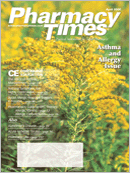Publication
Article
Pharmacy Times
Asthma Symptoms Are Highly Controllable
Author(s):
The annual impact of asthma is severe: 2 million emergency department (ED) visits, 500,000 hospitalizations, and 6000 deaths.1-3 Life-threatening acute episodes escalate quickly; the resultant inflammation and airway constriction require immediate intervention. In the United States, 27 million asthma sufferers (6.3 million of whom are children) often require long-term control and prevention strategies.1,3
Symptom Triggers
Environmental triggers can exacerbate asthma attacks. Triggers fall primarily into 2 categories: allergens (eg, animal dander, dust mites, cockroaches, pollen, mold); and irritants (eg, cigarette smoke, air pollution, fumes, scented products, strong emotional expressions such as crying or laughing). Other triggers include medications such as aspirin and beta-blockers, sulfites in food or beverages, and gastroesophageal reflux disease. These triggers can worsen asthma symptoms, especially at night.1,4
Treatment Guidelines
Experts agree that, with proper management, the symptoms of asthma are highly controllable. Pharmacotherapy includes rescue medications for acute attacks and long-acting agents to prevent future attacks. The National Asthma Education Prevention Program's (NAEPP) 1991 evidence-based treatment guidelines were last updated in 2002.5 These guidelines identify 4 steps of asthma severity (Table 1). Therapy should be stepped up as needed, but stepped down when possible to minimize medication exposure.5 Table 2 lists agents recommended at each step. Patients on Steps 3 and 4 should be referred to an asthma specialist.
Guidelines for acute attacks recommend 2 to 4 puffs of a short-acting inhaled beta-2-agonist bronchodilator as needed (albuterol, pirbuterol, or levalbuterol). Depending on symptom severity, patients may need up to 3 puffs at 20-minute intervals or a single nebulizer treatment. Systemic corticosteroids may be required. Long-term controlling agents should be considered if patients use a short-acting beta-2-agonist more than twice a week, or for any patient with a pattern of increasing use6 (Table 3).
Care Components
Although universally endorsed, consensus guidelines are not consistently applied. Many patients have poorly controlled asthma, perhaps due to misdiagnosis, lack of a written asthma management plan, inadequate patient education, and lack of follow-up. One study reported that, among children, for example, 67% had experienced asthma symptoms within a 24-hour period, 23% had required ED visits during the preceding year, and 54% lacked an asthma management plan.2
To facilitate successful outcomes, the NAEPP established 10 clinical activities, organized under 4 major components that are key for optimal outcomes5 (Table 4).
Action Plan
Effective treatment mandates patient education. Providers must ensure that patients use inhalers properly. Research demonstrates that all aerosol devices work equally well, and patient characteristics should drive device selection.7 If patients have problems with one type of device, providers should switch them to another. Providers must emphasize when to initiate rescue therapy, because patients often delay treatment.
Follow-up is crucial because patient education alone does not guarantee adherence. One study of near-fatal asthma attacks found that, despite adequate self-management knowledge, only 29% of patients used systemic corticosteroids, although 62% had had symptoms for more than 48 hours.2 Furthermore, patients overreport adherence. One study found that patients reported almost complete adherence, but actual inhaled corticosteroid use was only 58%.8
The treatment of asthma is highly patient-specific. As with other chronic morbidities, patient monitoring should be an ongoing process.
Dr. Zanni is a psychologist and health-systems consultant based in Alexandria,Va. Views expressed in this article are those of the author and not those of any government agency.
For a list of references, send a stamped, self-addressed envelope to: References Department, Attn. A. Stahl, Pharmacy Times, 241 Forsgate Drive, Jamesburg, NJ 08831; or send an e-mail request to: [email protected].







